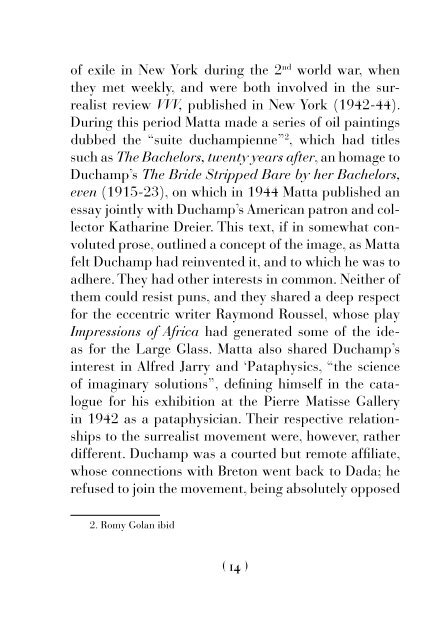Matta-Duchamp
Illustrated catalog featuring full page color illustrations and rare documentary photographs. Published by Galerie Gmurzynska in June 2018 to accompany a special cabinet exhibition at Art Basel 2018. The book includes texts by Professor Dawn Adès and Norman Rosenthal. It coincides with a broader re-evaluation of the importance of Matta internationally as well as of the influence of Duchamp on the work of 20th century artists. Edited and introduced by Krystyna Gmurzynska and Mathias Rastorfer. Essays by Dawn Adès and Norman Rosenthal. Historic interview excerpt by Robert Motherwell. 90 pages with 7 illustrations. Softcover. ISBN: 978-3-905792-09-6
Illustrated catalog featuring full page color illustrations and rare documentary photographs.
Published by Galerie Gmurzynska in June 2018 to accompany a special cabinet exhibition at Art Basel 2018. The book includes texts by Professor Dawn Adès and Norman Rosenthal. It coincides with a broader re-evaluation of the importance of Matta internationally as well as of the influence of Duchamp on the work of 20th century artists.
Edited and introduced by Krystyna Gmurzynska and Mathias Rastorfer.
Essays by Dawn Adès and Norman Rosenthal.
Historic interview excerpt by Robert Motherwell.
90 pages with 7 illustrations.
Softcover.
ISBN:
978-3-905792-09-6
Create successful ePaper yourself
Turn your PDF publications into a flip-book with our unique Google optimized e-Paper software.
of exile in New York during the 2 nd world war, when<br />
they met weekly, and were both involved in the surrealist<br />
review VVV, published in New York (1942-44).<br />
During this period <strong>Matta</strong> made a series of oil paintings<br />
dubbed the “suite duchampienne” 2 , which had titles<br />
such as The Bachelors, twenty years after, an homage to<br />
<strong>Duchamp</strong>’s The Bride Stripped Bare by her Bachelors,<br />
even (1915-23), on which in 1944 <strong>Matta</strong> published an<br />
essay jointly with <strong>Duchamp</strong>’s American patron and collector<br />
Katharine Dreier. This text, if in somewhat convoluted<br />
prose, outlined a concept of the image, as <strong>Matta</strong><br />
felt <strong>Duchamp</strong> had reinvented it, and to which he was to<br />
adhere. They had other interests in common. Neither of<br />
them could resist puns, and they shared a deep respect<br />
for the eccentric writer Raymond Roussel, whose play<br />
Impressions of Africa had generated some of the ideas<br />
for the Large Glass. <strong>Matta</strong> also shared <strong>Duchamp</strong>’s<br />
interest in Alfred Jarry and ‘Pataphysics, “the science<br />
of imaginary solutions”, defining himself in the catalogue<br />
for his exhibition at the Pierre Matisse Gallery<br />
in 1942 as a pataphysician. Their respective relationships<br />
to the surrealist movement were, however, rather<br />
different. <strong>Duchamp</strong> was a courted but remote affiliate,<br />
whose connections with Breton went back to Dada; he<br />
refused to join the movement, being absolutely opposed<br />
2. Romy Golan ibid<br />
( 14 )

















